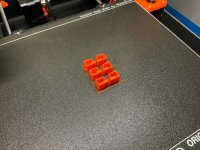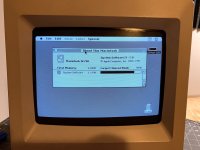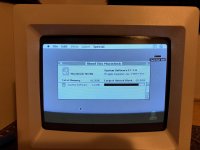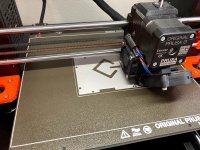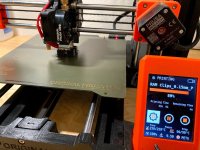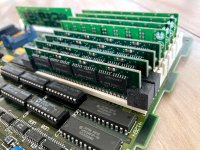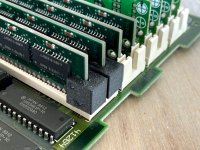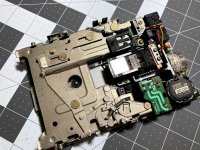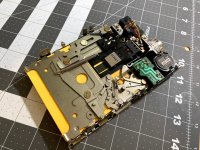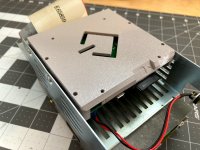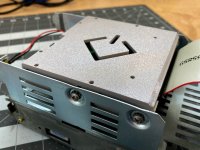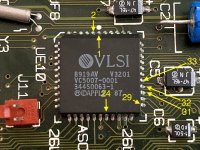Okay, time for another update! I am restoring several Macs all at the same time right now, so I happened to have a tub of hydrogen peroxide going outside, along with some hot sunny weather. With cold, cloudy weather on the horizon (and the other two Macs done with Retrobrite), I decided to get the SE/30 run through as well.
I'm also getting this written down now, because my photo roll on my phone is three Macs in various stages - very difficult to remember which is which!
Here it was before teardown.
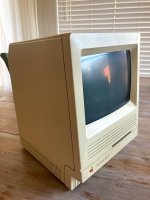
Pretty nice unit! A few scratches but nothing serious.
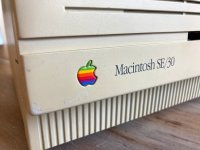
There must have been a sticker here.
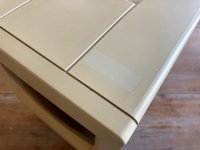
There are absolutely some stickers here! Remember that I bought this one off a guy in Portland, which is about a 6-hour drive from Boise, Idaho where I live.
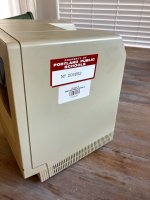
The back is in very nice shape.
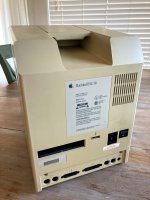
I had to get these stickers off before I could do retrobrite. I let them soak in Goo Gone for awhile, and then when after the white sticker with my fingernails. I got it off, but it was a real pain.
But nothing could prepare me for the pain of the red sticker! Not only was it difficult to peel... it broke off in teeny tiny pieces. Eventually I used a combination of hair dryer and flat razor blade to get it off. What a pain.
If you look closely, you can see where the UV got through the sticker over the years.
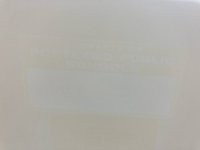
Time for teardown! Of course, the first step is to ALWAYS discharge the CRT, even if the machine has been sitting for months. If you are afraid of doing this, I encourage you to not be! I've never heard so much as a "click" when discharging these. Just follow the procedure to the letter, and you'll be fine.
Down to just the front panel!
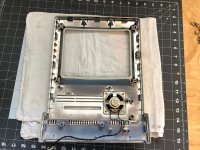
To get the speaker off, I just snip off the melted plastic posts with flush cutters. I was surprised to find a little rubber gasket in here. I've taken apart about 6 SE's now and I'd never seen one of these. But I've never taken apart an SE/30.

Of course, I popped out the Apple badge.
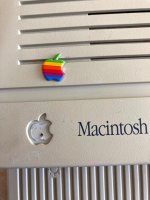
I didn't get any photos of Retrobrite in the sun, but this is the exact same container of peroxide from a couple days earlier. Once the water his 110°F, things really start moving. I used 5 or 6 32-oz bottles of 40-proof peroxide.
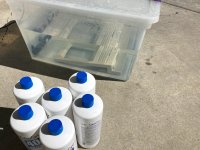
The back (bucket) had plenty of time in the sun and peroxide, but the front needed a little bit extra time after the weather turned bad. So I put it in the garage with the fish tank heater and UV light. To be honest, even after 10 hours, I didn't see much improvement. But I decided that it was good enough and moved on.

Last week, I placed an order from DigiKey, and with that order I got a muxer chip and some spares. It was very cheap - less than $1, so I ordered four to have some spares. I also ordered some Chip Quik, which is a special low-temperature solder designed to help you desolder SMD parts without a hot air station.
Here's the chip before desoldering. The legs are just an oxidized, awful mess!
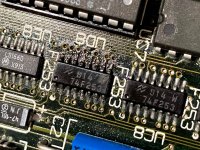
I didn't get any photos of the Chip Quik, but it's basically some pieces of "desoldering alloy". It melts extremely easily, and stays liquid for a super long time. You apply the included flux to the legs, and melt a bunch of solder on all the legs of the chip. Keep your iron moving around, the heat spreads onto all of the pads, and suddenly the chip pops off! I was surprised at how fast and easy it was.
This is the mess I was left with. The leftover flux hides the horrible condition of these pads. At first, I thought a bunch of pads were gone, but then I realized that they were covered in a truly impressive amount of junk. No wonder this chip wasn't working! Well... the chip probably worked fine, but it had little connectivity to the board.
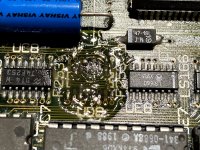
After cleaning up the flux with alcohol and cotton swabs, I added a bit more flux, and dragged the desoldering braid across everything a few times. Then I dug out the microscope to get a closer look. Ugh, what a mess! And this was after some cleaning!
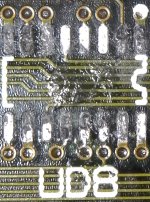
More flux...

I tried a whole bunch of stuff. Applying flux, and burning through the junk with the iron directly, scratching at each pad with my tweezers, and finally, a bunch of flux and dragging the desoldering braid across each pad. I found that if the braid had a bit of solder in it, and if I used it kinda like sandpaper, it eventually got through everything. I was shocked that I hadn't lifted any pads by this point!

As step before soldering down the chip: a bit more flux.
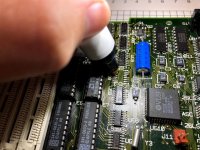
Time to solder down the chip! I didn't get a final photo, but my strategy is just like with my capacitors. I tin one leg, heat that pad, slide the part into place, and remove the heat. Then I solder all of the other pads, and drag away any excess solder. Not a perfect job, but it turned out okay!
In this photo the IC is a bit crooked, but I straightened it out.
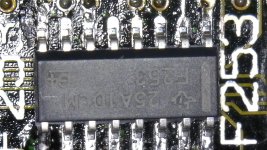
With the new chip soldered in, it was almost time to test! Aaaaaafter I reassemble the whole computer. First, I hot glued the speaker back in:
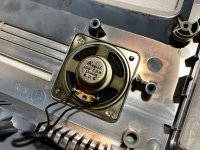
Chassis installed, CRT installed, then analog board (not shown):
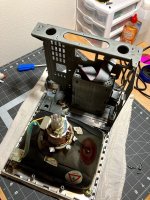
And now, the moment of truth... does it work?
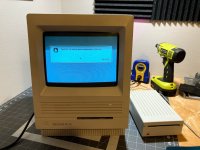
It does! Hooray! Not sure what the RAM complaint is all about. Just happy that I have an SE/30 that works!
I also did notice that the sound is not working; there's no chime. So I will be investigating both that and the RAM issue next. I guess it's also just about time to find some RAM for this machine... what's the crowd thing? 32, 64, or 128 MB of RAM? Let me know if you think you know what is wrong with the sound, and how much RAM I should install.

